Biomagnification

Biomagnification is the process where pollutants become concentrated in the tissues of organisms at higher trophic levels. In this activity students analyse and explain some simple data from a food chain including ring-billed gulls and discuss the trade-off between control of the malarial parasite and DDT pollution.
Lesson Description
 Guiding Question
Guiding Question
At times the fishing of certain carniverous fish is banned because of dangers to human health. Fish like farmed Salmon can also contain high concentrations of DDT. What could cause this toxicity?
Activity 1 - Global biomagnification of DDT
The interactive Thinglink map shows examples of animals which accumulate pesticides, Sparrowhawk, Orcas, Bald eagles and Nile crocodiles are just four examples. There are many others.
Explore the examples on the map, then answer the three short questions below.
Questions
1. What are the properties of DDT or PCB which allow these chemicals to bioaccumulate?
.................................................................................... ...............................................................................
.................................................................................... ...............................................................................
.................................................................................... ...............................................................................
2. Why does a preditor accumulate a higher concentration of DDT than the prey which it eats?
.................................................................................... ...............................................................................
.................................................................................... ...............................................................................
3 Name two examples of Bioaccumulation.
.................................................................................... ...............................................................................
.................................................................................... ...............................................................................
Suggested answers
1. What are the properties of DDT or PCB which allow these chemicals to bioaccumulate?
They are fat soluble, but not water soluble
They a persistent in the environment, they don't get broken down
They are not metabolised by organisms
2. Why does a preditor accumulate a higher concentration of DDT than the prey which it eats?
Preditors eat many of the prey, and they gradually accumulate all of the DDT which they have consimed, because it is not excreted (not water soluble) and it is not metabolised.
3 Name two examples of Bioaccumulation.
Sparrowhawks in the UK
Bald Eagle in the USA
Nile crocodile in Zimbabwe
Orca, killer whales in New Zealand
Activity 2 - IB style question
Answer the following data based question on this ![]() Biomagnification IB-style questions worksheet below.
Biomagnification IB-style questions worksheet below.
Activity 3 - Video extension
Rachel Carson was the first scientist to suggest that DDT was causing harm in natural ecosystems. Through a best selling book, Silent spring, she brought about a change in the way in which scientists thought about the balance of nature..
Watch the short ![]() Biomagnification video and the historical DDT footage (10 minutes)
Biomagnification video and the historical DDT footage (10 minutes) ![]() Pesticides DDT Rachel Carson Silent spring
Pesticides DDT Rachel Carson Silent spring
- What do you think could be the next case like DDT?
- Are there any chemicals used widely in the world today which could be having a bad long-term affect on human health?
- How would you communicate today your concerns about this 'silent danger'?
Teacher's notes
The first activity is a short introduction to the concept of biomagnification, and how top predators in a food chain can accumulate high concentrations of a toxin.
Activity two gives students an opportunity to explain these ideas, and practice a straightforward data analysis question.
There are some suggestions for the answers on this page Biomagnification IB style questions - model answers
The last activity is really extension. The historical video is really quite shocking, now that we know that DDT is quite toxic for human health.
Differentiation / Extension ideas
Polar bears in peril is an interesting way to introduce the concept of biomagnification as a "wide game" an activity where students chase each other over a limited area, like a sports field or an outdoor classroom.
Interactive game, Secrets at Sea from Vacouver aquarium is quite nice online puzzle and addresses killer whales, food webs and bioaccumulation. Learning

 IB Docs (2) Team
IB Docs (2) Team
